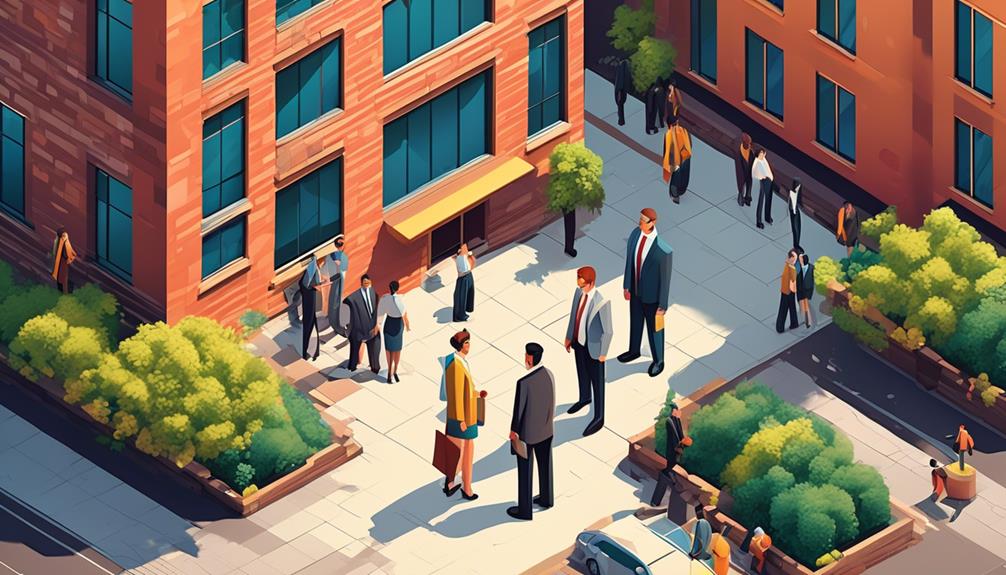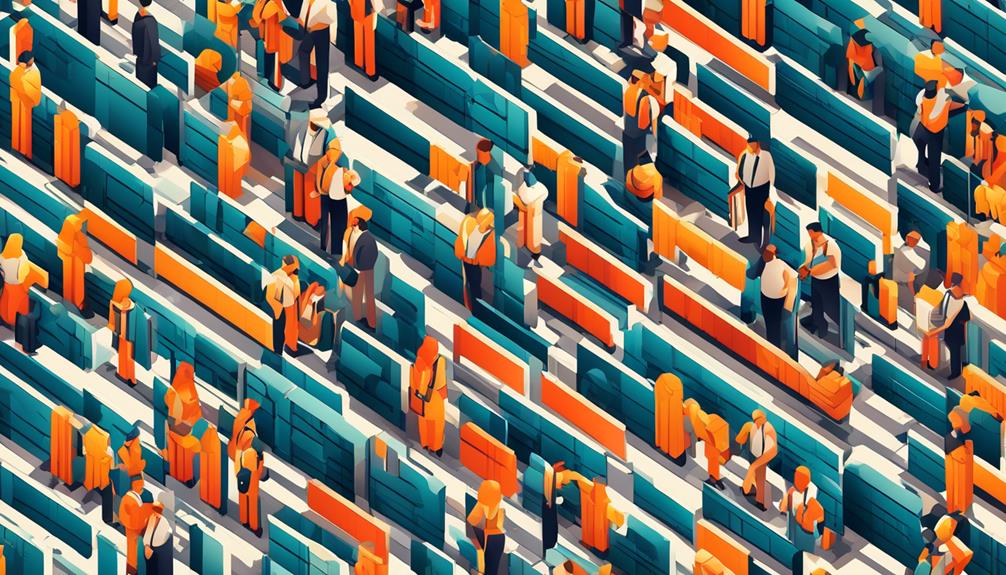As a writer, I was surprised to learn that 53% of high schools in the United States have strict dress codes in place. This statistic sheds light on the prevalence of dress code regulations in educational institutions and the potential impact they may have on students.
However, it's not just about the numbers. The implications of these dress codes reach far beyond the surface and have sparked important discussions about gender, race, and personal expression. These conversations are crucial in understanding the broader effects of dress code policies on students and society as a whole.
Key Takeaways
- 53% of high schools in the United States have strict dress codes in place.
- Dress codes disproportionately affect marginalized student groups, such as girls, Black students, and LGBTQ students.
- Dress codes limit the self-expression of transgender, gender-nonconforming, and nonbinary students.
- Dress codes impact the professional success of marginalized student groups.
Impact of Dress Codes on Academic Performance
The disproportionate impact of dress codes on certain student groups, such as girls, Black students, and LGBTQ students, can hinder academic performance and contribute to inequitable learning environments. When dress codes are strictly enforced, they often lead to the exclusion of these marginalized groups from various activities and result in harsh consequences for minor violations. The U.S. Government Accountability Office (GAO) report revealed that districts with stringent dress code policies predominantly enroll students of color, highlighting the inequitable impact of these regulations.
Moreover, dress codes frequently prohibit clothing items associated with specific genders, leading to unequal enforcement and causing learning time losses for students. Additionally, these codes contain rules about students' hair and head coverings, which disproportionately affect Black students and limit the self-expression of transgender, gender-nonconforming, and nonbinary students.
The strict enforcement of dress codes is associated with higher rates of exclusionary discipline, which disproportionately affects students of color and those from low-income backgrounds, ultimately creating a less equitable learning environment. These findings underscore the need to reevaluate dress code policies to ensure they don't hinder the academic success of marginalized student groups.
Influence of Dress Codes on Professional Success

As I reflect on the impact of dress codes on academic performance, it becomes evident that these regulations also significantly influence professional success, particularly for marginalized student groups. When considering the influence of dress codes on professional success, it's important to note the following:
- Dress codes disproportionately target girls, Black students, and LGBTQ students, leading to unequal enforcement and consequences.
- The U.S. Government Accountability Office (GAO) report found that districts enforcing dress codes strictly predominantly enroll students of color, raising concerns about equity and fairness.
- Dress codes commonly ban clothing items associated with girls, such as halter tops and short skirts, leading to gender-based discrimination and impact on professional success.
These facts highlight the detrimental impact of dress codes on the professional success of marginalized student groups. It's crucial to address these disparities and advocate for inclusive and equitable dress code policies to ensure that all students have the opportunity to thrive in their future careers.
Prevalence of Dress Codes in Workplaces
I see workplace dress codes as a common practice in many professional environments.
Employers often enforce these policies to maintain a certain standard of appearance and professionalism.
Employees may navigate these requirements while expressing their personal style within the bounds of the dress code.
Workplace Dress Code
In my experience, workplace dress codes are prevalent across various industries and can significantly impact employees' daily routines and professional image. When exploring workplace dress codes, it's important to consider the following:
- Dress codes can vary widely, from formal business attire to casual dress, depending on the industry and company culture.
- Certain professions, such as finance or law, often have strict dress code requirements, while tech companies and creative industries may have more relaxed standards.
- Dress codes can influence perceptions of professionalism and affect employee morale and productivity.
Understanding the nuances of workplace dress codes is crucial for navigating professional environments and ensuring that one's attire aligns with organizational expectations.
Dress Code Enforcement
Enforcing dress codes in workplaces often leads to inequities and disproportionate impact on certain groups, as highlighted by statistics showing the targeting of girls, Black students, and LGBTQ students. The enforcement of dress codes involves subjective language that often targets LGBTQ and Black students, leading to exclusionary disciplinary actions. Prohibited clothing items and rules about hairstyles disproportionately impact students from minority racial or cultural groups, resulting in unfair disciplinary actions. Additionally, restrictions on head coverings and hairstyles disproportionately affect Black students and those with religious or cultural practices. To address these inequities, it is imperative for the U.S. Department of Education to provide guidance and resources for fairer dress code policies. Fair and equitable dress code enforcement is essential for creating an inclusive and supportive environment for all individuals.
| Statistics | Impact |
|---|---|
| Disproportionate targeting of girls, Black students, and LGBTQ students | Exclusionary disciplinary actions |
| Subjective language in dress codes | Unfair targeting of LGBTQ and Black students |
| Prohibited clothing items and hairstyle rules | Disproportionate impact on minority racial or cultural groups |
| Restrictions on head coverings and hairstyles | Disproportionate impact on Black students and those with religious or cultural practices |
Employee Dress Choices
The inequities highlighted in dress code enforcement extend to the prevalence of dress codes in workplaces, raising concerns about their impact on employee dress choices.
As we delve into the prevalence of dress codes in workplaces, it's essential to consider the following points:
- The implementation of dress codes may disproportionately affect employees from minority racial or cultural groups, limiting their choices in work attire.
- Strict dress code enforcement can lead to discriminatory actions and may contribute to a lack of inclusivity within the workplace.
- The impact of dress codes on employee morale and productivity should be carefully examined to ensure a positive and supportive work environment.
Understanding the implications of workplace dress codes is crucial in promoting diversity, equity, and inclusion within organizational settings.
Effects of Dress Policies on Social Environments

Disproportionate enforcement of school dress codes has a significant impact on the social environment, particularly for marginalized groups such as girls, Black students, and LGBTQ students. These policies often result in unequal treatment and consequences for these groups. As a result, exclusionary discipline and learning loss are prevalent, especially among students of color and those from low-income backgrounds.
Moreover, dress codes frequently target natural, textured hair and head coverings, disproportionately affecting Black students and those with religious or cultural headwear. The subjective language in these policies, present in 93% of dress codes, allows for interpretations that frequently lead to the targeting of LGBTQ and Black students. Additionally, the invasive nature of enforcement, including body and clothing measurements by staff members in around 60% of cases, further exacerbates this issue.
The need for fairer dress code policies to foster a more equitable and safe school environment has led to calls for guidance and resources from the U.S. Department of Education. It's crucial to address the adverse effects of these policies on the social environment to ensure that all students feel included and valued.
Gender Disparities in Dress Code Enforcement

Experiencing the effects of dress code policies firsthand, I've observed how gender disparities in enforcement disproportionately impact girls, contributing to a discriminatory environment within schools. This issue is pressing, and here are some reasons why it matters:
- Girls are often disproportionately targeted by dress codes, leading to unfair treatment and a sense of inequality within the school environment.
- This disparity can affect girls' self-esteem and perpetuate harmful gender norms.
- It can also lead to a diversion of educational resources towards enforcement rather than supporting students' learning and well-being.
- Additionally, it creates a hostile environment that hinders the overall educational experience.
These gender disparities in dress code enforcement not only affect the individual students but also contribute to a broader culture of discrimination and inequity within educational institutions.
It's crucial to address these disparities and work towards creating dress code policies that are fair and equitable for all students.
Racial and Cultural Implications of Dress Codes

As I consider the racial and cultural implications of dress codes, I'm struck by the evident stereotyping and bias in their enforcement. These dress codes disproportionately target students of color and those from minority cultural groups, leading to unfair and discriminatory treatment.
It's crucial to acknowledge the impact of these policies and work towards creating more inclusive and equitable dress codes.
Stereotyping in Dress Codes
In examining dress codes, it becomes evident that racial and cultural stereotypes significantly influence the enforcement and impact of these regulations. This issue is underscored by the following points:
- School dress codes disproportionately target girls, Black students, and LGBTQ students, leading to discriminatory consequences such as suspensions and exclusions.
- Dress codes often lack equitable enforcement and disproportionately affect black and brown students, perpetuating racial and gender biases.
- Prohibited clothing items and rules on hairstyles in dress codes disproportionately impact students from minority racial or cultural groups.
These facts highlight the pressing need to address the racial and cultural implications of dress codes, as they contribute to inequitable environments and discriminatory practices in educational settings.
Bias in Enforcement
Dress code enforcement in schools perpetuates racial and cultural biases, leading to discriminatory outcomes for marginalized students.
It's undeniable that dress codes disproportionately target girls, Black students, and LGBTQ students, resulting in biased enforcement.
For instance, a high school girl was suspended for wearing a slightly off-shoulder top, while an assistant principal drew on a Black boy's head in permanent marker to cover up a shaved design in his hair. These actions not only affect students' self-esteem but also contribute to the criminalization of boys of color and the sexualization of Black girls.
Additionally, strict dress code enforcement is linked to higher rates of exclusionary discipline, particularly impacting students of color and those from low-income backgrounds.
Furthermore, the lack of religious exemptions for head coverings affects students with diverse cultural and religious practices.
These facts underscore the urgent need to address the racial and cultural implications of dress codes in schools.
Psychological Effects of Dress Code Regulations

The enforcement of dress code regulations can significantly impact students' psychological well-being and self-esteem. As a student, I've personally felt the effects of dress code regulations on my mental health. Here are some crucial points to consider:
- Body image and self-esteem: Strict dress codes can lead to body shaming and decreased self-esteem, especially for girls and LGBTQ students who may feel targeted or objectified.
- Emotional well-being: Constant scrutiny and fear of punishment for minor dress code violations can lead to anxiety, stress, and a negative school experience for many students.
- Sense of belonging: Dress code regulations that target specific cultural or racial attire can make students feel excluded and disconnected from their cultural identity, impacting their sense of belonging in the school community.
It's essential to recognize the psychological toll that dress code regulations can take on students. Understanding and addressing these effects is crucial for creating a supportive and inclusive school environment.
Frequently Asked Questions
What Are Some Common Reasons Why Schools or Workplaces Implement Dress Codes?
Schools or workplaces implement dress codes to promote safety, equity, and professionalism. They aim to prevent bullying, reduce crime, and prepare students for the workforce. Dress codes also seek to create an inclusive environment and protect against discrimination.
How Do Dress Codes Vary Between Different Industries or Academic Institutions?
Dress codes vary between industries and academic institutions, reflecting their unique cultures and norms. In some fields, formal attire is the norm, while others embrace casual dress. These differences shape professional and educational environments.
Are There Any Studies That Show the Correlation Between Dress Codes and Self-Esteem or Confidence?
Yes, studies show a correlation between dress codes and self-esteem and confidence. They can disproportionately impact certain groups, leading to exclusionary discipline and reinforcing inequities, as evidenced by real-life examples and research findings.
What Are Some Alternative Options to Traditional Dress Codes That Have Been Successful in Promoting a Positive Environment?
Some successful alternatives to traditional dress codes include gender-neutral policies for more inclusivity, uniforms to reduce disparities and foster unity, cultural expression to promote diversity, and guidelines focusing on personal expression and comfort for a positive atmosphere.
How Do Dress Code Policies Differ Between Countries or Regions?
Dress code policies vary widely between countries and regions, reflecting diverse cultural norms and values. These differences shape how individuals express themselves through clothing and contribute to the rich tapestry of global fashion.
Conclusion
In conclusion, the statistics clearly show that dress codes have a significant impact on academic performance, professional success, and social environments.
While some may argue that dress codes are necessary for maintaining a professional and respectful atmosphere, it's important to recognize that they can also perpetuate inequality and discrimination.
By promoting more inclusive and equitable dress code policies, we can create a visual representation of a more diverse and accepting community.










